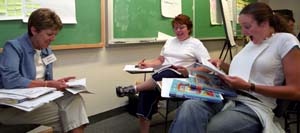School is back in session, and teachers are making sure that students are all on the same page.
But what about the teachers? Shouldn’t they be on the same page, too?
Getting on that page involves a balancing act. Elementary- and high-school teachers need to match their instruction to state standards and district curriculum.

They must reinforce knowledge from previous grades and include new information. And teachers need to give tests that provide an accurate picture of students’ learning.
While it may sound simple, getting content, teaching methods and testing to work together — and then to coordinate across grade levels — is an annual challenge.
As the federal government requires more accountability from school districts, these efforts have a heightened importance. The No Child Left Behind Act (NCLB) mandates that states test each student every year in grades 3-8, and takes away money from schools where students do not meet performance standards.
Teachers from five school districts are working with WUSTL science- and math-education faculty members in an effort to align curriculum to the NCLB standards and to improve instruction. Their work is supported by $6.5 million from the National Science Foundation, through funding from NCLB.
The St. Louis Math and Science Partnership (MSP) provides professional development and teaching materials designed to help schools provide challenging curriculum and close achievement gaps. For teachers in St. Louis MSP partner districts Ferguson-Florissant, Maplewood-Richmond Heights, Riverview Gardens, University City and Webster Groves, that means summers are spent preparing for the coming school year.
In summer 2004, 53 partner district teachers attended graduate courses at the University, and another 92 teachers participated in curriculum-planning sessions and enrichment activities.
Jere Confrey, Ph.D., professor of math education in Arts & Sciences, taught a graduate course for elementary teachers on not only rational number operations, but also on methods teachers can use to help children understand them.
Confrey and the teachers found that their experiences in teaching division were similar. Children are most easily able to divide by two, then by four and eight, then by 10 and five, then by three, six and nine. The hardest factor for children to learn is seven.
Instead of introducing factors in numerical order, Confrey suggested teaching them in the order of difficulty. She also suggested looking around the school environment for equal groups, like windowpanes, that will help children visualize multiplication and division.
“Rational number is probably the most critical concept for children to learn if they’re going to succeed in advanced math,” Confrey said. “We’re trying to provide a foundation for kids, and we’re going beyond what’s required by testing.
“To get kids to understand math, you have to get into deeper cognitive issues.”
St. Louis MSP teachers also had the opportunity to take a graduate course in science instruction and assessment. Kathy DiRanna, K-12 alliance director for WestEd, leads the professional development objective of the Center for the Assessment and Evaluation of Student Learning. She and her colleagues helped teach the course.
WestEd is a nonprofit research, development and service agency that works with education and other communities to promote excellence. It is headquartered in San Francisco with 17 offices nationwide, mostly in California.
“Assessment is a vital part of the teaching and learning cycle, and it’s an important tool teachers can use to monitor student progress,” DiRanna said. “Like good teaching practices, good assessment is grounded in standards and in the research about how students learn.”
Terri Thomas, an eighth-grade science teacher at Brittany Woods Middle School in University City, took the science assessment course with two of her colleagues.
“Our group picked force and energy to focus on,” Thomas said. “We found our kids typically don’t do well in it. We thought a different, more organized approach might be better.”
As a school partner in the St. Louis MSP, Brittany Woods will receive kits and materials that Thomas and her colleagues can use to help students develop an understanding of the concepts. They will continue to meet as a group with MSP personnel throughout the year.
“I’m excited about being able to chart kids’ progress,” Thomas said.
The course also helped teachers understand how assessment is more than giving tests.
“We even looked at a class activity as an assessment,” Thomas said. “Good assessment involves a lot of observing, keeping an accurate record of who’s done what, rather than just putting a grade in a grade book. Assessment can be telling you where to go.”
As the school year goes on, St. Louis MSP personnel will stay in contact with teachers, making classroom visits, conducting follow-up sessions and delivering materials.
“We’re helping teachers throughout the year,” said Victoria May, director of science outreach.
“Teachers might tell us that they don’t feel comfortable teaching a certain subject, and we match up experts who can help them gain the content knowledge. Or they say they don’t have the materials they need to give their kids hands-on experiences, and we can provide science kits that the teachers select to match their curriculum.”
It’s all part of keeping science and math education — and teachers and students — on the same page.